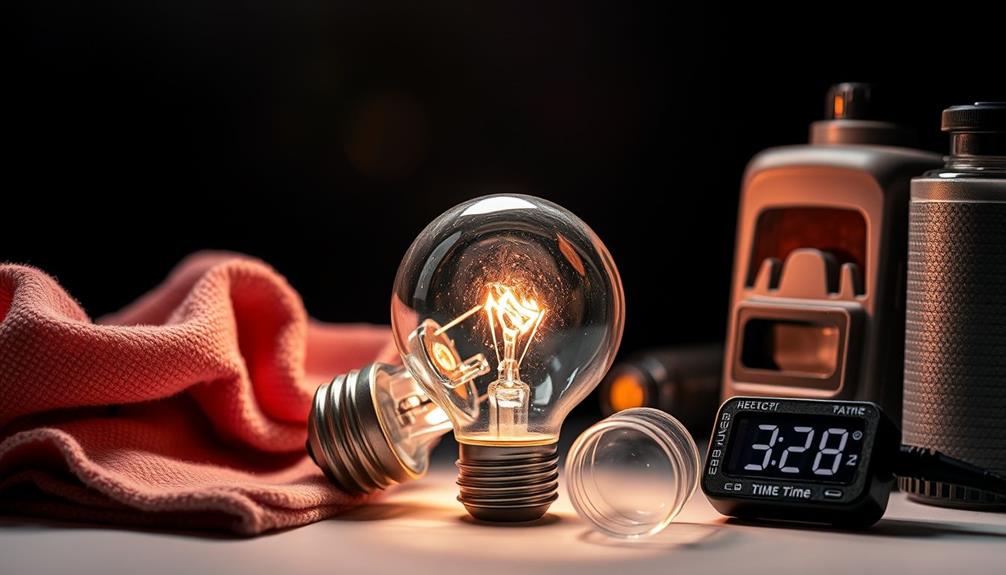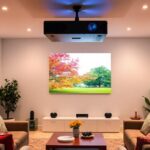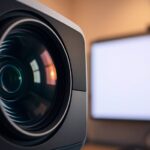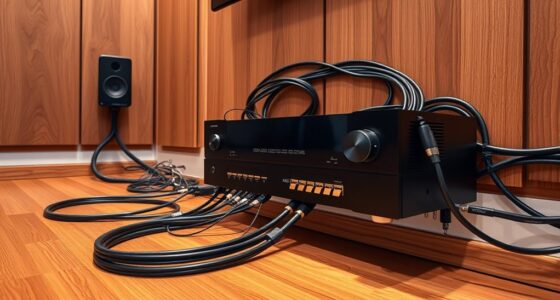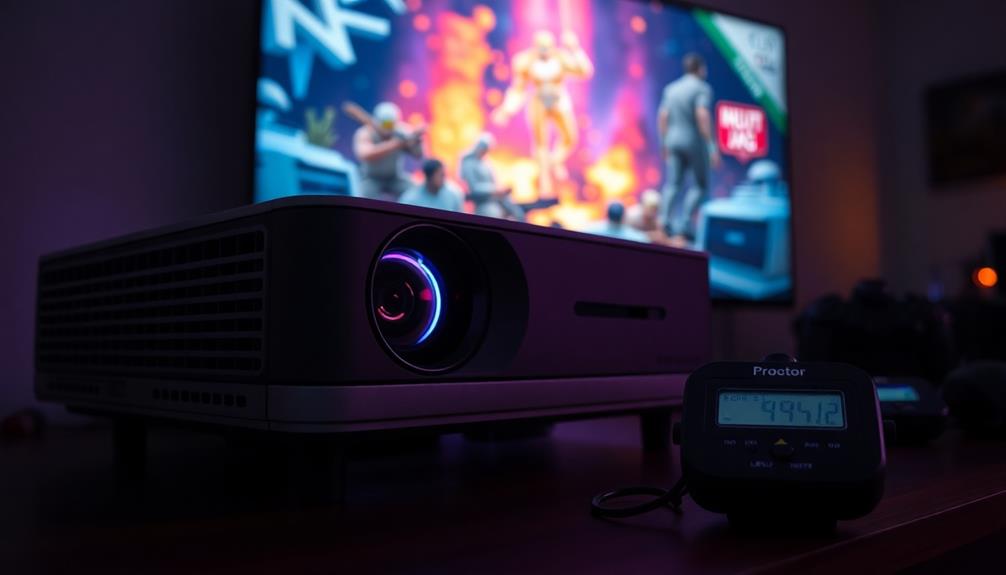When searching for the best projectors for small spaces and apartments, consider short-throw models that project large images from just a few feet away. Look for brightness in the 1,000 to 3,000 lumens range for clear visuals, even in well-lit rooms. Lightweight and portable options like the BenQ GV1 Mini are ideal for easy transport. The Optoma HD146X impresses with high lumens and sharp resolution, making it perfect for vibrant viewing. Don't forget about connectivity, too. You'll want multiple HDMI ports for all your devices. There's a lot more to explore on how to enhance your space!
Key Takeaways
- Short-throw projectors like BenQ TH671ST can project large images from just 4 to 5 feet away, perfect for limited spaces.
- Aim for projectors with at least 1,000 to 3,000 lumens brightness for clear visuals in both bright and dim environments.
- Lightweight and portable models, such as BenQ GV1 Mini, enhance flexibility for spontaneous use in small apartments.
- Look for projectors with multiple HDMI ports and wireless connectivity to minimize cable clutter and simplify device connections.
Key Features to Consider

When choosing a projector for small spaces, you'll want to focus on key features like throw distance, brightness, and connectivity options to confirm a seamless viewing experience.
First, consider the throw distance. Short-throw projectors are perfect for compact areas, allowing you to project large images from as close as 4 to 8 feet away. This means you won't have to rearrange your entire room just to fit a projector.
Next, think about brightness. A projector with a brightness range of 1,000 to 3,000 lumens is advisable for small rooms. This level of brightness guarantees clear images, even if there's ambient light, making your viewing experience much more enjoyable.
Portability is another vital factor. Look for lightweight and compact designs that make it easy to move the projector around. In small apartments, flexibility is key, so having a projector that you can easily set up in different rooms or take outside can be a game changer.
Top Projector Recommendations
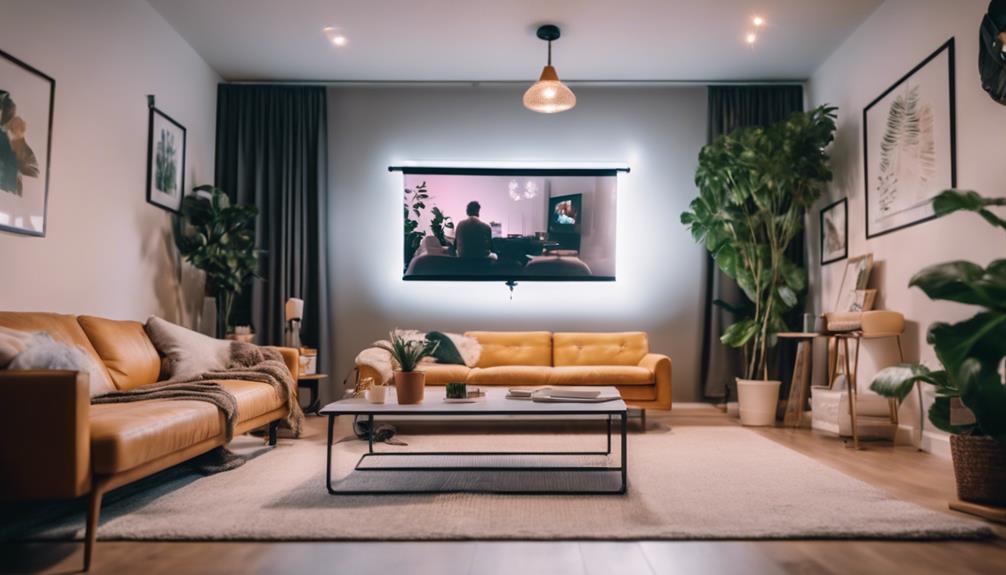
Explore the best projector options for small spaces to enhance your viewing experience without sacrificing precious room. Whether you're looking for great image quality or portability, there's a projector that fits your needs perfectly.
- Optoma HD146X: This projector for small areas boasts 1080p resolution and 3600 lumens brightness, ensuring vibrant images even in well-lit rooms.
- BenQ TH671ST: A short-throw projector that creates a 100-inch display from less than five feet away, making it a fantastic choice for compact spaces and gaming.
- XGIMI HORIZON XM13N: Offering 4K resolution and Dolby Vision, this projector delivers sharp visuals with 2300 ISO lumens brightness, perfect for streaming in limited environments.
- BenQ GV1 Mini: Ideal for on-the-go use, this ultra-portable projector has wireless connectivity and a built-in battery, making it a great option for spontaneous movie nights.
With these options, you can enjoy a cinematic experience tailored to your living situation.
Connectivity Options Explained
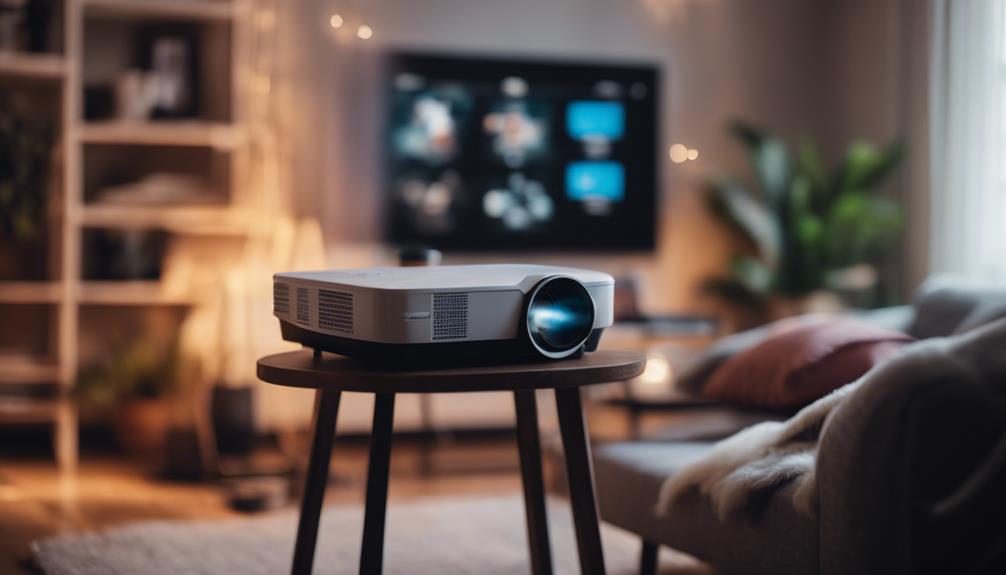
Choosing the right projector is just the start; understanding the various connectivity options can greatly enhance your viewing experience in small spaces.
First off, having multiple HDMI ports is essential. They allow you to connect various devices like streaming boxes, gaming consoles, and laptops seamlessly, making your projector incredibly versatile.
In addition to HDMI, USB inputs can be a game-changer. They let you access media directly from flash drives, which means quick and convenient playback without the need for extra devices cluttering your space.
Don't overlook wireless connectivity options, either. Features like Wi-Fi and Bluetooth help you eliminate cable clutter, simplifying your setup process. This makes it easy to switch between devices, a significant benefit in tight areas.
For business or educational settings, compatibility with wireless presentation systems is critical. It enables secure, fast connections without the mess of physical cables.
Plus, many modern projectors support popular streaming technologies like Google Cast and AirPlay, allowing you to stream directly from your mobile devices.
With these connectivity options, you'll maximize your projector's potential in any small space.
Performance Evaluation Criteria
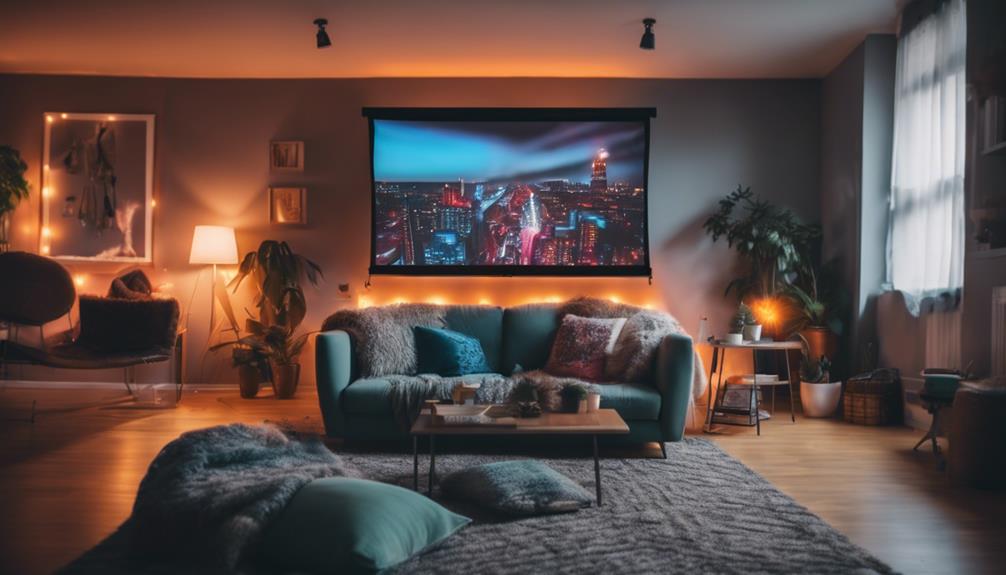
When evaluating projectors for small spaces, you'll want to focus on brightness and clarity first. A projector's lumens can make a huge difference in how well it performs in various lighting conditions.
Moreover, features such as projector maintenance tips can enhance longevity and performance over time.
In addition, make certain that it offers the right connectivity and compatibility to suit your devices seamlessly.
Brightness and Clarity
In small spaces, achieving ideal brightness and clarity is essential for an enjoyable viewing experience, so aim for projectors that offer at least 1,000 lumens and a resolution of 1080p. This range guarantees you get clear images even with ambient light. If you can, consider a projector with a higher resolution like 4K for even sharper detail.
When evaluating projectors for brightness and clarity, keep these points in mind:
- Lumens: Look for models with 1,000 to 3,000 lumens for maximal brightness.
- Resolution: A minimum of 1080p provides the clarity needed in smaller rooms.
- Contrast Ratio: Higher contrast ratios, like 25,000:1, enhance color depth and image clarity.
- Fan Noise: Quieter models create a more immersive experience without distractions.
Connectivity and Compatibility
While brightness and clarity set the foundation for a great viewing experience, the right connectivity and compatibility features elevate the projector's functionality in small spaces.
Look for projectors with multiple HDMI and USB ports to connect various devices effortlessly. This versatility is essential in compact living areas, as it allows you to switch between laptops, gaming consoles, and streaming devices without hassle.
Wireless connectivity options like Bluetooth and Wi-Fi can greatly reduce cable clutter. By enabling seamless integration with your favorite streaming apps, you can enjoy movies and shows without the need for additional hardware. When evaluating projectors, check their compatibility with popular streaming platforms to maximize your entertainment options.
Additionally, consider how easily you can switch between devices. A user-friendly interface will enhance your experience, making it convenient to enjoy different media sources.
Finally, don't overlook performance factors such as brightness and fan noise, especially in small rooms where ambient light and sound can impact your viewing pleasure.
Budget-Friendly Selections
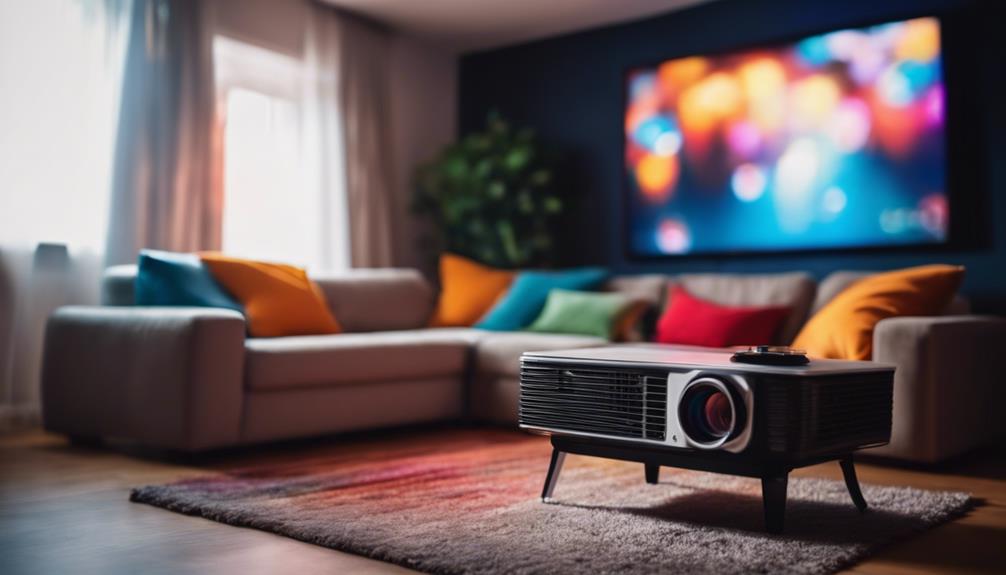
Budget-friendly projectors can transform your small space into a personal cinema without breaking the bank. You don't need to sacrifice quality for affordability. Here are some great options that fit your budget and space constraints:
- BenQ GV1 Mini: A compact projector with wireless connectivity and a built-in battery, offering three hours of casual viewing—perfect for small apartments.
- ViewSonic M1: This budget projector shines with 250 lumens brightness and a six-hour battery life, ideal for on-the-go entertainment.
- Vimgo P10: Priced under $200, this portable mini projector delivers decent brightness but may compromise on color quality, making it a smart choice for tight budgets.
- Anker Nebula Solar: A portable projector priced at $399.99, it boasts 1080p resolution and three hours of battery life, suitable for both indoor and outdoor settings.
With these options, you can enjoy a cinematic experience right at home without overspending!
Understanding Projector Types

When choosing a projector for your small space, it's essential to understand the different technologies available.
Each type, whether DLP, LCD, or laser, has unique benefits that can impact your viewing experience.
Knowing these options will help you find the best fit for your specific needs and room size.
Different Projector Technologies
Understanding different projector technologies can help you choose the perfect model for your small space, as each type offers unique advantages and limitations. Here's a quick overview to guide your decision:
- DLP projectors use a digital micromirror device (DMD) chip, delivering high contrast and compact designs, making them great for portability.
- LCD projectors rely on liquid crystals to provide bright images with sharpness and color accuracy, ideal for well-lit environments.
- Laser projectors utilize laser diodes, offering exceptional brightness and color precision with longer lifespans—up to 30,000 hours—perfect for small spaces.
- LED projectors are known for their energy efficiency and longevity, often being lightweight and portable.
Ideal Use Cases
Short-throw projectors excel in small rooms, allowing you to enjoy large images without needing extensive space between the screen and the projector. For instance, models like the BenQ TH671ST can project impressive visuals from just 4 to 5 feet away, making them perfect for apartments where every inch counts.
If you're looking for versatility, consider portable projectors like the BenQ GV1 Mini. Its compact design and built-in battery make it easy to use in tight spaces or even outdoors. Plus, DLP projectors are typically smaller and offer high contrast ratios, enhancing image quality for cozy environments.
When brightness is a priority, opt for projectors like the Optoma HD146X, which boasts 3600 lumens. This high brightness guarantees clear, vibrant images, even in well-lit rooms, making it great for casual viewing with friends or family.
Lastly, projectors with wireless connectivity, such as the XGIMI HORIZON XM13N, provide a clutter-free setup. You can effortlessly switch between devices, making your small living area feel more organized while still enjoying the big-screen experience.
Essential Setup Accessories

To create an ideal viewing experience in small spaces, you'll need essential setup accessories like projector screens, mounts, and quality audio solutions. These accessories can help enhance your projector's performance and improve your overall viewing enjoyment.
Here are some must-have items for your setup:
- Projector Screen: A high-quality screen, such as the Silver Ticket STR Series, improves image clarity and brightness.
- Projector Mount: Consider a projector mount like the Peerless-AV PRGS-UNV for secure installation and prime positioning, keeping your space tidy.
- HDMI Cables: Stock up on various HDMI cables to guarantee seamless connectivity between your projector and devices.
- Audio Solutions: Enhance your audio experience with external speakers or soundbars, especially since many projectors have limited built-in audio.
Evaluating Image Quality
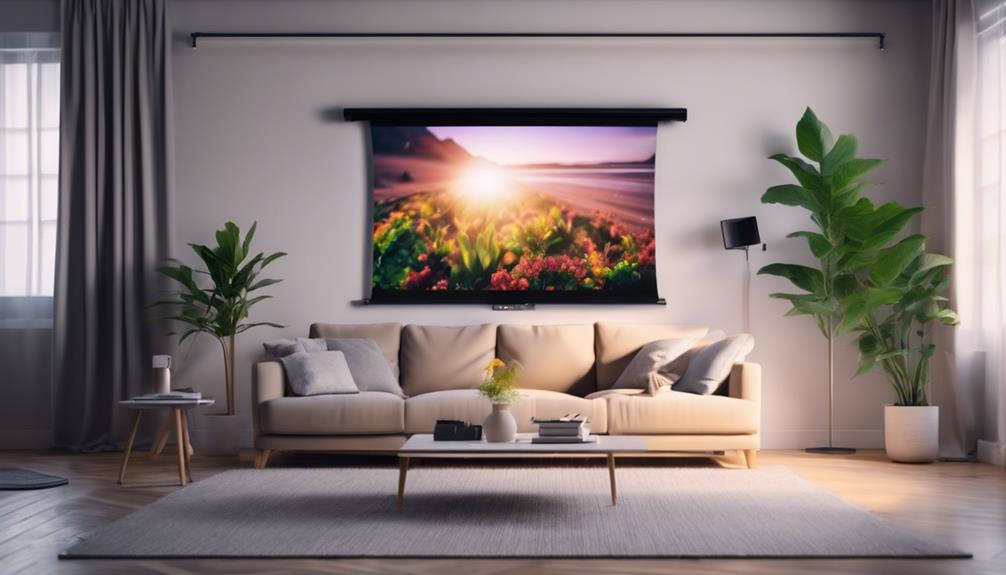
When you evaluate image quality in projectors, brightness and clarity are your top priorities.
Aim for at least 1,000 ANSI lumens in darker rooms, while brighter spaces benefit from 1,500 ANSI lumens or more.
Additionally, don't overlook the contrast ratio, as a higher ratio can greatly enhance the depth and vibrancy of your images.
Brightness and Clarity
Brightness plays an essential role in achieving clear visuals in small spaces, with a recommended range of 1,000 to 3,000 lumens for ideal image quality. This lumen range guarantees that your projected images remain vibrant, even in rooms with ambient light.
To help you understand the importance of brightness and clarity, consider the following:
- Higher lumens provide better visibility in well-lit areas.
- 1080p resolution assures sharp and detailed images suitable for various viewing needs.
- Short-throw projectors are perfect for tight spaces, projecting large images from a short distance.
- Quality screens can greatly enhance brightness and clarity compared to projecting onto plain walls.
When you're selecting a projector, remember that brightness directly impacts your viewing experience. A brighter image not only enhances clarity but also improves the overall color depth, making your content pop.
Always consider your space's lighting conditions to choose the right projector for the best image quality.
Contrast Ratio Importance
Understanding the contrast ratio is essential to evaluating the overall image quality of a projector, as it influences the vibrancy and detail of the visuals you see. The contrast ratio measures the difference between the darkest black and the brightest white that a projector can produce. A higher contrast ratio results in more vibrant and detailed images, making your viewing experience more immersive.
For example, projectors like the Optoma HD146X feature an impressive contrast ratio of 25,000:1, greatly enhancing color depth. This is particularly important in small spaces where ambient light can wash out your visuals.
Projectors with lower contrast ratios, especially below 1000:1, often deliver washed-out images that lack clarity. As a result, it's vital to choose projectors with at least a 3000:1 ratio to guarantee satisfactory performance.
When considering 4K models, the impact of contrast ratio becomes even more pronounced on larger screens, enhancing your overall viewing experience.
Maintenance and Longevity

To maintain your projector's performance and extend its lifespan, regularly clean the air filter and lens to prevent dust buildup. Neglecting this simple maintenance can lead to reduced image quality and shorten your projector's operational life.
Additionally, consider the lamp life when selecting your projector; models like the Optoma HD146X offer around 15,000 hours, which cuts down on replacements and maintenance costs.
Here are some essential tips for keeping your projector in top shape:
- Clean the air filter every few months to guarantee proper airflow.
- Check and adjust brightness settings to reduce lamp wear, especially in darker environments.
- Keep the projector in a well-ventilated area to prevent overheating.
- Utilize LED or laser projectors for longer lamp life and reduced maintenance efforts.
Limitations to Keep in Mind
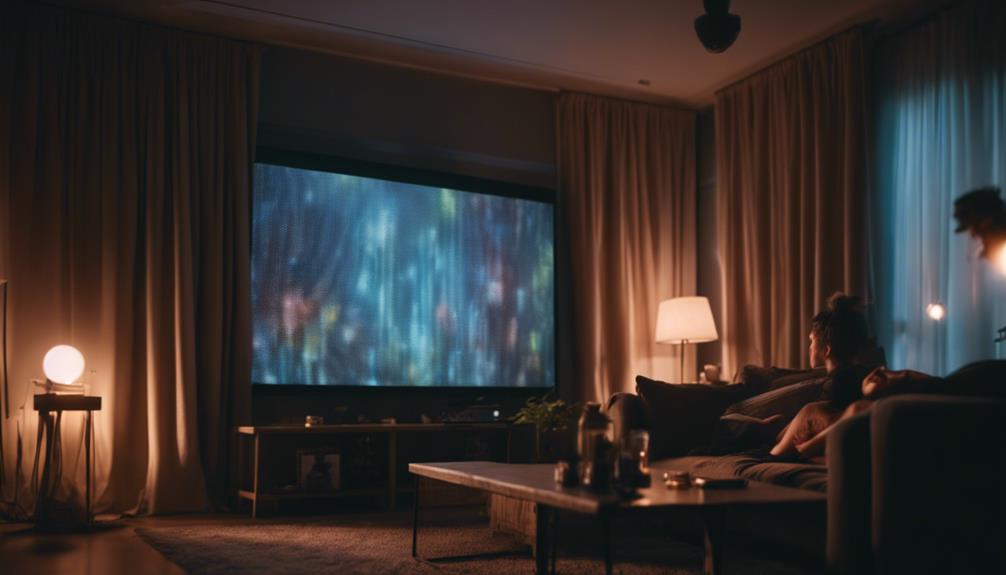
While short-throw projectors are perfect for small spaces, you'll need to be aware of their limitations, including potentially lower brightness levels and reduced sound quality.
Many portable projectors range from 250 to 1,000 lumens, which can make it tough to enjoy a clear image in well-lit rooms. If you're planning to watch movies in daylight or bright environments, this could be a significant drawback.
Additionally, the compact design of these mini projectors often leads to compromised audio quality. You might find that the built-in speakers lack the power you need for an immersive experience, so investing in external speakers becomes essential.
Moreover, limited connectivity options can pose challenges. Smaller projectors may not support all your devices out of the box, requiring extra adapters or wireless solutions to connect. This can be frustrating if you want a hassle-free setup.
Frequently Asked Questions
Are Projectors Good for Small Rooms?
Yes, projectors can be great for small rooms. They create impressive images without taking up much space, and models with high brightness and low input lag enhance your viewing experience, whether for movies or gaming.
Can You Put a Projector in an Apartment?
Yes, you can definitely put a projector in your apartment. Whether it's for movie nights, gaming sessions, or presentations, modern projectors are compact, bright, and designed for versatile setups in limited spaces. Enjoy the experience!
What Is the Best Projector for Everyday Use?
For everyday use, you'll want a projector that balances quality and convenience. Look for options like the Optoma HD146X for great brightness and resolution, or the compact BenQ GV1 Mini for easy portability and wireless streaming.
Can a Projector Replace a Tv?
Imagine a window to a cinematic world; you'll find a projector can indeed replace a TV. With stunning visuals and smart features, it transforms your space into an entertainment hub, offering flexibility and immersive experiences.
Conclusion
In a world where space is often at a premium, the right projector can transform your small apartment into a cinematic haven.
Choosing the perfect model isn't just about size; it's about balancing performance with practicality. While some projectors offer stunning visuals, others shine in connectivity and affordability.
By understanding your needs, you can enjoy the thrill of big-screen entertainment without sacrificing valuable space.
So, embrace the possibilities and elevate your viewing experience today!

